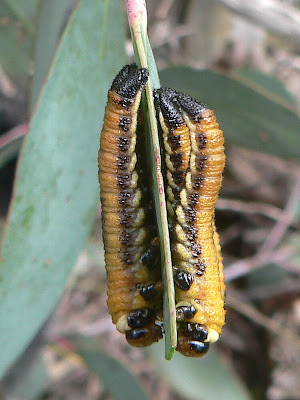Last time I looked at yellow colouring in vertebrates; today it's the turn of the 'little world', where of course most of the action really happens. Like birds, many insects use plant-derived carotenoids, though many other pigment groups, including anthraquinones and flavinoids, are involved.
In some beetles - notably ladybirds - it seems that the yellow is carotenoid-based, but that it doesn't come from plants. However the beetles can't make it either, but apparently derive it from symbiotic bacteria.
 |
| Ladybird, probably Harmonia sp., Brindabella Mountains near Canberra. |
+nr+Cooktown+0506.jpg) |
| Leopard Longicorn Beetle Penthea pardalis, Cooktown, tropical Queensland. Possibly a similar story to the ladybird, but I doubt that the details of its colouring have been studied. |
Yellow and black wasps are saying the same thing, though they're not relying on being unpalatable; their sting is a very effective reinforcement of the message. Their yellows are mostly xanthopterins, which are also responsible for animal urine being yellow. There are exciting suggestions around that in at least some wasps the xanthopterin is converting sunlight to electrical impulses across the cuticle, enabling extra activity during the peak of the day when other insects are avoiding the sun. The main work seems to have been done on the Oriental Hornet Vespa orientalis; I have no idea if others can perform the same trick.
 |
| European Wasp Vespula germanica (on chicken), Canberra. This has become an environmental and social scourge since being introduced to Australia. |
 |
| Spider-hunting wasp, Isla de Chiloe, Chile. |
In some circumstances however yellow can be a most effective camouflage. I only noticed this little flower spider when it moved as I was interpreting the flower structures to a class group!
 |
| Flower Spider, family Thomisidae, probably Diaea sp. National Botanic Gardens, Canberra. I have no idea of the origin of its yellow, though its purpose is clear. |
Butterflies and moths don't utilise carotenoids, unlike most of the other groups I've mentioned, but many take flavonoids from plant sources.
 |
| Butterflies, San Pedro area, southern Peru. |
 |
| Moth, Limbe, western Cameroon. |
In the pierids (family Pieridae, including the familiar Cabbage White), dark colours are due to pigments strongly bonded to chitin in the wing scales, while bright ones - including yellow - are powdery on the surface of scales.
 |
| Large Grass Yellow Eurema hecabe (Pieridae), 40 Mile Scrub Nature Reserve, north Queensland. |
Some butterfly groups however are more specialised in their pigmentation.The wonderful swallowtails, family Papilionidae, have their very own pigments, papiliochromes which are yellow or red-brown.
 |
| Papilionid, Manu National Park, Peruvian Amazonia; showing off its papiliochromes. |
I should offer at least a gallery of yellow flowers too to complete this mini-series, though it will be hard making a choice - yellow is a very popular colour in the plant world!
BACK ON TUESDAY



No comments:
Post a Comment